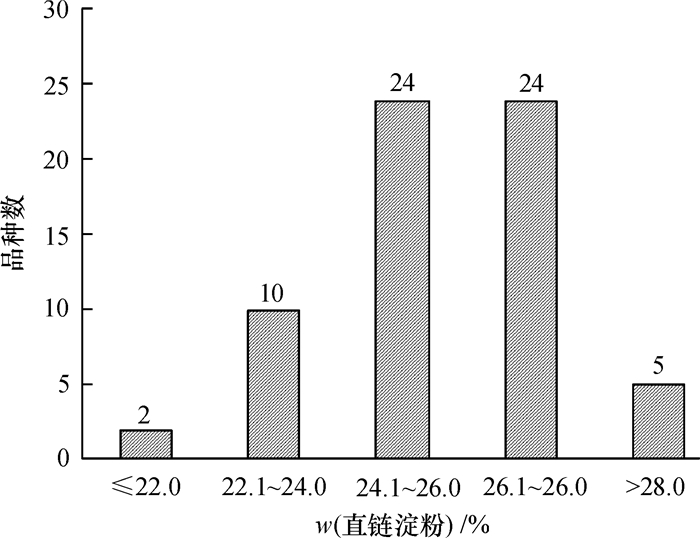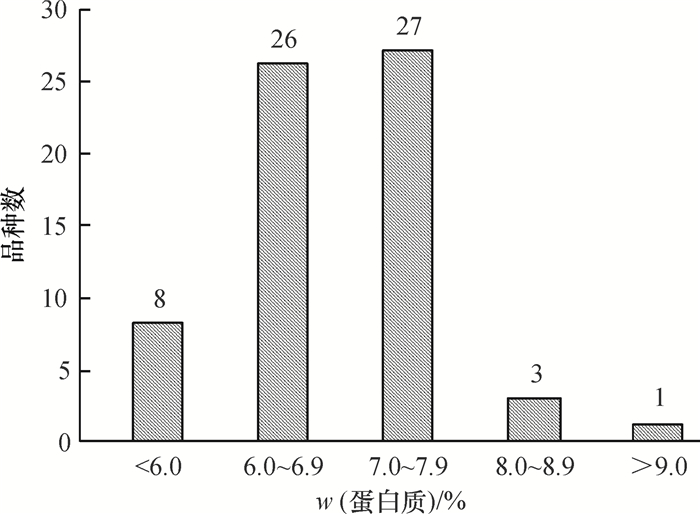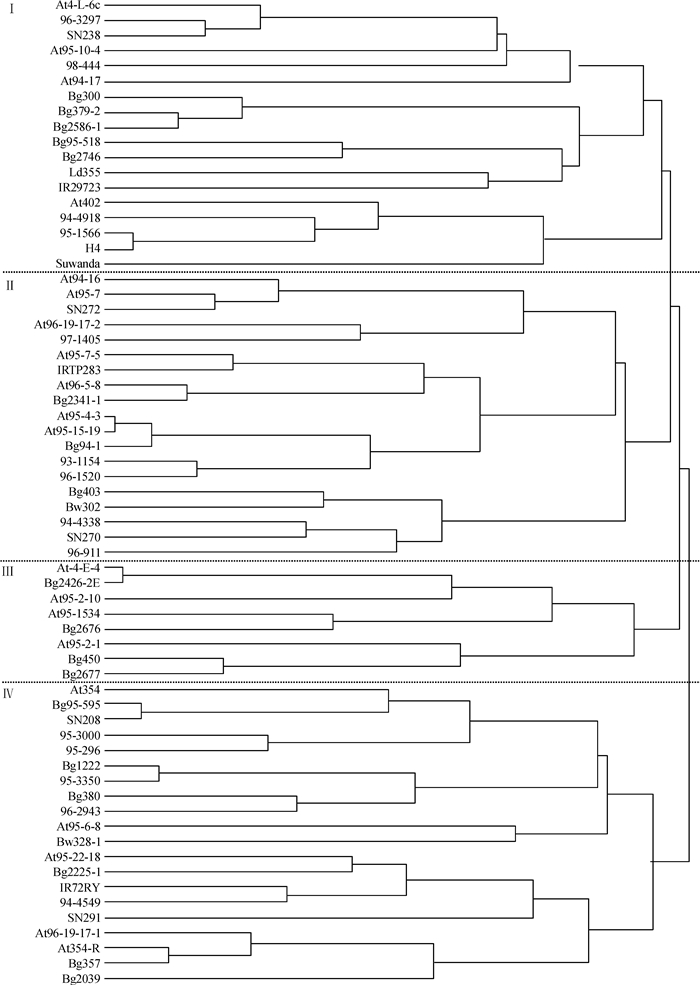Evaluations of cooking, eating and nutritional qualities of indica rice cultivars introduced from Sri Lanka
-
摘要:目的
对引自斯里兰卡的水稻品种进行蒸煮食用及营养品质分析,以期发现可利用的优良或特殊的稻种资源材料, 以利于我国水稻生产和育种。
方法2014年4—10月,以引进的65个籼稻品种为材料,采用单因素随机区组排列,进行田间常规种植收获后,对各品种的蒸煮食用品质和营养品质进行分析。
结果各品种直链淀粉的质量分数为21.35%~29.34%,供试品种间表现差异不显著;蛋白质质量分数为5.24%~9.17%,供试品种间表现为显著差异;氨基酸总含量中必需氨基酸占33.80%~36.30%,非必需氨基酸占63.70%~66.20%。相关性分析和主成分分析表明,营养品质因子(氨基酸)对稻米品质影响最大(贡献率为53.447%),其含量越高,稻米直链淀粉含量越低,同时蒸煮食用品质越差。通过聚类分析,65个品种被归为4类,各具特点。
结论所引进的水稻品种,特点不一,可作为原材料供将来生产和育种选用。
Abstract:ObjectiveThe cooking, eating and nutritional qualities of rice cultivars introduced from Sri Lanka were analyzed so as to screen the suitable materials for rice production and breeding.
MethodSingle factor randomized block design was applied in 2014, and 65 rice cultivars introduced from Sri Lanka were planted under conventional cultivation. After harvest, rice samples from each cultivar were collected for cooking, eating and nutritional analysis.
ResultAmylose contents were between 21.35%-29.34% across all cultivars and there were no significant differences. Protein contents were 5.24%-9.17% and significantly differed among cultivars. Essential and non-essential amino acids accounted for 33.80%-36.30% and 63.70%-66.20% of total contents of amino acids, respectively. Based on correlation and principal analysis, the nutritional factor (amino acids) contributed 53.447% to the rice qualities. Higher contents of amino acids were associated with lower amylose contents, and lower cooking and eating qualities. All 65 rice cultivars were classified into 4 types through clustering analysis, and each of them exhibited different characteristics.
ConclusionThe introduced rice cultivars show different characteristics and can be used as raw materials for future rice production and breeding.
-
稻种资源是开展水稻育种及其相关科学研究的重要物质基础,世界上许多国家及国际机构已充分认识到种质资源对作物育种的卓越贡献[1]。我国虽属稻种资源大国,但仍然存在着稻种资源匮乏、优质品种少、利用率低、种质资源丧失及对稻种资源研究不够深入等问题[2-3]。此外,我国由于地域性广、生态复杂等原因,稻作生产中易遭受各种病虫害、温度、干旱等生物和非生物胁迫的影响而损失产量[4]。引进国外优异稻种,对于丰富我国稻种资源及提高水稻产量具有意义[5-6]。近60年来因直接或间接引进国外水稻资源而增产的稻谷超过7 730万t,创造了巨大的经济效益[7]。持续开展稻种资源的收集和整理,完善稻米种质资源评价体系,是我国水稻生产及育种可持续发展的重要保证和举措[1]。
目前,我国引进的稻种资源主要来自于日本、韩国以及东南亚国家和地区,这些稻种由于高产、抗病虫、耐旱耐热、优质等特点,为我国水稻品种生产和改良做出了重要贡献[5, 8]。斯里兰卡属于南亚热带稻作区,该地区由于土壤危害、病虫害严重等原因,水稻品种普遍具抗源性广泛、抗逆性强等特点[5]。近些年来,关于斯里兰卡水稻种质资源品质性状的研究鲜有报道,为进一步丰富我国水稻种质资源,本文在前人研究的基础上,对65个从斯里兰卡引进的水稻品种进行蒸煮食用及营养品质的分析,以期发现可利用的优良或特殊稻种资源材料,为水稻生产和育种提供基础材料。
1. 材料与方法
1.1 供试材料与试验设计
试验于2014年4—10月在四川农业大学教学农场进行。4月播种,5月移栽。供试土壤为紫色土,基础肥力为:土壤有机质20.18 g·kg-1,全氮1.31 g·kg-1,速效氮110.95 mg·kg-1,速效磷26.52 mg·kg-1,速效钾143.42 mg·kg-1,pH 6.60。
试验选用从斯里兰卡引进的65个籼稻Oryza sativa subsp.indica品种为材料,采用单因素随机区组排列,小区面积为4 m2 (2 m×2 m),行穴距为25 cm×18 cm。大田采取统一管理措施,保证水稻生长过程的水肥供应。收获后15 d,取一部分样品粉碎并过100目筛,用于蒸煮及营养品质测定。另取样品保存,用于蒸煮食用品质感官评价。
1.2 品质测定方法
稻米的蒸煮食用品质及营养品质测定均在农业部西南作物生理生态与耕作重点实验室进行。
1.2.1 蒸煮食用品质测定
直链淀粉含量测定:根据农业部NY147-88[9]方法,称取0.100 g粗淀粉样品于15 mL试管中,先后加入无水乙醇1 mL和1 mol·L-1的NaOH溶液9 mL,混合震荡后沸水浴中加热10 min,冷却后转移至100 mL容量瓶并定容,过滤,吸取5 mL样液,加入1 mol·L-1乙醇1 mL和碘液1.5 mL,静置20 min后, 在620 nm下比色。
淀粉的黏滞性测定:称取3.00 g含水量(w)10%左右的水稻粉样, 加入25 mL水, 搅拌均匀,使用RVA (Rapid viscosity analyzer)仪测定。运行参数:50 ℃条件下保持1 min,以11.84 ℃·min-1的速度上升到95 ℃,并保持2.5 min,再以11.84 ℃·min-1的速度下降到50 ℃,并保持1.4 min。搅拌器的转速在起始10 s内为960 r·min-1,之后保持在160 r·min-1。并记录峰值黏度、热浆黏度、崩解值、冷胶黏度、消减值、到达峰值黏度时间以及糊化温度。
蒸煮食用品质感官评价:采用GB/T15682—2008[10]并结合曹萍等[11]介绍的日本农林水产食味测定的相关方法进行。选择性别、年龄平衡的20个人组成评定小组。用电饭锅,在同一条件下煮饭,然后每人对外观、香气、味道、黏度、硬度、综合评价共6项指标进行评定:以极差-5分、很差-4分、较差-3分、略差-2分、稍差-1分、一般0分、极好5分、很好4分、较好3分、略好2分、稍好1分等评分标准进行评价打分,用每人评价分值的平均值进行评定,每次每组评定品种数不超过11个。
1.2.2 营养品质测定
蛋白质含量采用全自动凯氏定氮仪测定。称取精米样品0.300 g放于消化管中,加入消化片与浓硫酸,然后置于高温通风橱,在350 ℃条件下进行硝化,消化完成待液体冷却后使用Buchi AGB-339全自动凯氏定氮仪(瑞士步琦公司)测定成熟籽粒含氮量,换算成蛋白质含量(以干质量为计),换算系数为5.95。
氨基酸组分含量使用氨基酸分析仪进行测定。称取精米样品0.200 g于带塞试管中,并加入6 mol·L-1的HCl 8 mL,盖上塞子,震荡后置于冰箱冷冻。结冰后取出试管,加入适当氮气排除空气,在110 ℃烘箱中烘22 h。待试管冷却至室温,用旋转蒸发仪蒸干液体,用0.02 mol·L-1的稀HCl溶液清洗并过滤于100 mL的容量瓶中,定容。吸取5 mL液体于25 mL容量瓶中并定容,最后使用针头移液管吸取样品,置于收集瓶中,使用日立公司L-8800型氨基酸全自动测定仪(日本日立公司)进行氨基酸测定(氨基酸含量以干质量为计)。
1.2.3 相关性、主成分及聚类分析
根据刘百龙等[12]方法,使用SAS Enterprise Guide 4.3和JMP 9等分析软件进行相关性、主成分及聚类分析。
1.2.4 数据分析
以上蒸煮食用与营养品质测定均至少重复3次,并使用SAS Enterprise Guide 4.3进行方差分析及显著性检验,用Excel制图表。
2. 结果与分析
2.1 水稻蒸煮食用品质分析
稻米的蒸煮品质是稻米在蒸煮过程中所表现出来的理化特性,是衡量稻米品质优劣的主要指标。由图 1和表 1可知,直链淀粉质量分数变幅在21.35%~29.34%,平均值为25.66%,在供试品种间差异不显著。根据NY/T593—2002[13]食用稻品质标准,有2个品种的直链淀粉质量分数<22.0%,达优质一级标准,其分别是At95-7-5和96-911;10个品种直链淀粉质量分数在22.1%~24.0%,达优质二级标准,占总数的15.38%;24个品种直链淀粉质量分数在24.1%~26.0%,达优质三级标准,占36.92%。可见,达优质标准的品种占总数的55.38%。
表 1 65个水稻品种的蒸煮品质Table 1. Cooking qualities of 65 rice cultivars
RVA黏度值可以间接反应稻米的蒸煮品质。如表 1所示,RVA各参数除到达峰值黏度时间外,其余参数在供试品种间表现为显著或极显著差异。影响稻米蒸煮品质的主要参数指标是崩解值和消减值,崩解值大则米饭较软,消减值小则米饭软而不黏结。本试验中崩解值和消减值的范围分别是10.59~75.00 RVU (Rapid visco unit,仪器单位)和34.04~109.84 RVU,变幅分别达到33.63%和26.06%。RVA各指标变异系数由大到小是:崩解值>热浆黏度>消减值>峰值黏度>冷胶黏度>到达峰值黏度时间>起始糊化温度。
稻米蒸煮食用品质感官评价是指通过人主观的观、闻、尝等方法对稻米的外观、味道、香气、黏度、硬度以及综合评价的综合得分,是衡量稻米食用品质的重要指标之一。如表 2所示,感官评价各指标在供试品种间表现为极显著差异,且变异系数较大。硬度、香气和综合评价3项指标表现优异的品种较多,分别占76.92%、63.08%和55.38%。外观和味道表现优异的品种分别占43.38%和38.46%,而黏度最低,仅占2.31%。综合起来,各指标均表现优异的品种有5个,分别是At402、94-4918、95-1566、SN238和H4。
表 2 65个水稻品种蒸煮食用品质感官评价Table 2. Comparisons of sensory evaluation of 65 rice cultivars
2.2 水稻营养品质分析
蛋白质含量是衡量和评定稻米营养品质的主要指标之一。由图 2和表 3可知,蛋白质含量在供试品种间表现为显著差异。总体来说,蛋白质质量分数在5.24%~9.17%之间,变异系数为11.56%。多数品种蛋白质质量分数在6.0%~8.0%之间,4个品种的蛋白质质量分数≥8.0%,达优质二级标准以上,分别为Bg2676、Bg2677、At95-1534和At95-2-10;27个品种的蛋白质质量分数介于7.0%~7.9%,达优质三级标准,占总数的41.54%;26个品种的蛋白质质量分数介于6.0%~6.9%,达四级标准,占总数的40.0%;8个品种的蛋白质质量分数<6.0%,占总数的12.31%。
表 3 65个水稻品种的蛋白质和氨基酸含量Table 3. The contents of protein and amino acids of 65 rice cultivars
供试水稻品种共检测出17种氨基酸,包括必需和非必需氨基酸,各氨基酸组分含量在供试品种间表现为显著或极显著差异。各品种必需氨基酸占总氨基酸含量的33.80%~36.30%,非必需氨基酸占总氨基酸含量的63.70%~66.20%,可见,稻米中的氨基酸以非必需氨基酸为主。必需氨基酸以亮氨酸(Leu)和天冬氨酸(Asp)含量最高,非必需氨基酸以谷氨酸(Glu)、精氨酸(Arg)和脯氨酸(Pro)为主。
2.3 相关性及主成分分析
稻米品质的相关性如表 4所示,直链淀粉含量与崩解值呈显著正相关,而与蛋白质及各氨基酸组分均呈显著负相关,说明蛋白质含量高的品种,其直链淀粉含量低、崩解值低、食味差。峰值黏度和热浆黏度均与冷胶黏度、消减值及峰值时间呈极显著正相关,而与糊化温度呈显著负相关。冷胶黏度和消减值均与峰值时间呈极显著正相关,硬度与冷胶黏度和消减值均呈显著正相关,说明峰值黏度高的品种,其RVA谱表现的黏度值(热浆黏度、冷胶黏度、消减值)越高,米饭越硬。此外,蛋白质和个别氨基酸与RVA(除糊化温度)呈显著负相关。多数氨基酸与糊化温度呈显著正相关,表明氨基酸含量过高,会降低蒸煮食用品质。另外,蛋白质及各氨基酸之间均呈极显著正相关(P<0.01,表略)。
表 4 65个水稻品种蒸煮食用品质与营养品质的相关性分析1)Table 4. Correlation analysis among cooking, eating, and nutritional qualities for 65 rice cultivars
为了进一步分析归纳影响稻米品质的因素,对32项指标进行主成分分析,通过相应的特征值和特征向量(λ),选取前5个(λ1~λ5)作为评价品质的主成分,累计贡献率为88.741%(表 5)。第1主成分中,以各氨基酸的特征向量最大,可以看作是营养品质因子,第1主成分特征向量越大,直链淀粉含量越低,糊化温度越高。第2主成分中,以消减值、味道、黏度和硬度的特征向量最大,第2主成分特征向量越大,消减值和硬度越高,而味道和黏度越低。第3主成分以综合评价、香气、热浆黏度和峰值黏度的特征向量最大。第4主成分以崩解值、外观和糊化温度的特征向量最大,崩解值越高,外观和糊化温度越低。将第2、3、4主成分综合起来可以看作是蒸煮食用品质。第5主成分以香气、酪氨酸和蛋氨酸的特征向量最大,可以看作是感官与营养品质联合因子,香气值越高,酪氨酸和蛋氨酸含量越低。
表 5 65个水稻品种的品质性状主成分特征向量1)Table 5. Eigenvectors of rice qualities based on principal component analysis for 65 rice cultivars
2.4 聚类分析
以32个指标为依据,将各数值标准化后进行ward法聚类分析,将65个品种分为4类(图 3)。第Ⅰ类包括At4-L-6c、96-3297、SN238、At95-10-4、98-444、At94-17、Bg300、Bg379-2、Bg2586-1、Bg95-518、Bg2746、Ld355、IR29723、At402、94-4918、95-1566、H4和Suwanda等18个品种,这一类具有较高的外观、口味、黏度及综合评价值,而峰值黏度、热浆黏度、冷浆黏度、消减值和硬度较低,即该类品种具有较好的蒸煮食用品质;第Ⅱ类包括At94-16、At95-7、SN272、At96-19-17-2、97-1405、At-95-7-5、IRTP283、At96-5-8、Bg2341-1、At95-4-3、At95-15-19、Bg94-1、93-1154、96-1520、Bg403、Bw302、94-4338、SN270和96-911等19个品种,该类品种具有较高的峰值黏度、热浆黏度、冷胶黏度、消减值和香气,即具有较低的蒸煮食用品质;第Ⅲ类包括At-4-E-4、Bg2426-2E、At95-2-10、At95-1534、Bg2676、At95-2-1、Bg450和Bg2677等8个品种,该类品种具有较高的蛋白质和氨基酸含量,而直链淀粉含量、崩解值、外观、香气、口味、黏度较差,即具有较高的营养品质;第Ⅳ类包括At354、Bg95-595、SN208、95-3000、95-296、Bg1222、95-3350、Bg380、96-2943、At95-6-8、Bw328-1、At95-22-18、Bg2225-1、IR72RY、94-4549、SN291、At96-19-17-1、At354-R、Bg357和Bg2039等20个品种,该类品种具有较低的蛋白质和氨基酸含量,而直链淀粉含量、硬度较高,即具有较低的营养品质和蒸煮食用品质。
3. 讨论与结论
从以上结果可以看出,引进的斯里兰卡水稻多数品种直链淀粉含量较高(平均值25.66%),蛋白质含量适中(平均值6.90%),这同杨金华等[14]对斯里兰卡的稻种资源分析结果基本一致。总体来说,65个供试品种中,有36个和57个品种分别达到直链淀粉、蛋白质含量国家优质标准,这表明引进的水稻品种具有良好的品质特性,可为水稻生产和育种提供优质资源。
稻米的适口性是一个受多方面因素影响的评价指标[15]。其中,淀粉(或直链淀粉)含量被普遍认为是影响稻米蒸煮食用品质的重要指标[16-18]。斯里兰卡引进水稻多数品种直链淀粉含量较高,这可能与斯里兰卡消费习惯相关,收获后的稻谷并非直接碾磨为大米食用,而是直接把稻谷进行蒸煮后晾干,再储藏或碾为大米食用,高直链淀粉便于在蒸煮后进行储藏或碾磨[19]。虽然各供试品种间的直链淀粉含量差异不显著,但RVA和食用品质感官评价却有所差别,表明除了直链淀粉,其他的组分例如蛋白质和氨基酸也对稻米的品质有着影响[20]。前人对蛋白质与蒸煮食用品质相关分析结果表明,蛋白质与消减值呈显著正相关,而与热浆黏度、崩解值、峰值黏度等呈显著负相关[17, 21-23]。在本试验中,蛋白质与崩解值呈显著负相关,而与其他RVA或感官评价指标关系不显著。一般而言,优良的稻米崩解值较高,热浆黏度、冷胶黏度、消减值和糊化温度较低[16, 24]。这表明蛋白质含量越高,稻米蒸煮食用品质表现越差。
供试品种的氨基酸以谷氨酸、亮氨酸、脯氨酸、精氨酸和天冬氨酸为主,其中必需氨基酸占总含量的33.80%~36.30%,非必需氨基酸占63.70%~66.20%,与前人的研究结果基本一致[25-26]。在必需氨基酸中,赖氨酸被认为是稻米蛋白质合成的第一限制性氨基酸,苏氨酸和蛋氨酸则分别是第二、三限制性氨基酸[15, 27]。在本试验中,赖氨酸、苏氨酸和蛋氨酸含量分别占氨基酸总含量的4.34%、3.15%和1.79%,变异系数相对较高,说明育种中可根据不同需求选择育种材料。值得注意的是氨基酸含量并非越高越好,多数氨基酸组分与糊化温度呈显著正相关,这表明氨基酸含量升高反而会降低稻米蒸煮食用品质。通过主成分分析可知,营养品质因子(氨基酸)对稻米品质的累积贡献率达到53.447%,表明在优质品种选育中应重视对营养品质的选择。
通过聚类分析,65个水稻品种被分为4类,第Ⅰ类具有较高的蒸煮食用品质,包括At4-L-6c等18个品种;第Ⅱ类具有较低的蒸煮食用品质,包括At94-16等19个品种;第Ⅲ类具有较高的营养品质,包括At-4-E-4等8个品种;而第Ⅳ类具有较低的营养品质和蒸煮食用品质,包括At354等20个品种。在将来水稻生产及育种中,可以根据这些品种的不同特性进行选育,以丰富优质水稻生产和育种资源。
-
表 1 65个水稻品种的蒸煮品质
Table 1 Cooking qualities of 65 rice cultivars

表 2 65个水稻品种蒸煮食用品质感官评价
Table 2 Comparisons of sensory evaluation of 65 rice cultivars

表 3 65个水稻品种的蛋白质和氨基酸含量
Table 3 The contents of protein and amino acids of 65 rice cultivars

表 4 65个水稻品种蒸煮食用品质与营养品质的相关性分析1)
Table 4 Correlation analysis among cooking, eating, and nutritional qualities for 65 rice cultivars

表 5 65个水稻品种的品质性状主成分特征向量1)
Table 5 Eigenvectors of rice qualities based on principal component analysis for 65 rice cultivars

-
[1] 韩龙植, 曹桂兰.中国稻种资源收集、保存和更新现状[J].植物遗传资源学报, 2005, 6(3): 359-364. doi: 10.3969/j.issn.1672-1810.2005.03.025 [2] 叶卫军, 胡时开, 李媛媛, 等.水稻种质资源的分子鉴定和育种利用[J].分子植物育种, 2013, 11(4): 625-633. http://d.old.wanfangdata.com.cn/Periodical/fzzwyz201304031 [3] SONG Z, LI B, CHEN J, et al. Genetic diversity and conservation of common wild rice (Oryza rufipogon) in China[J]. Plant Spec Biol, 2005, 20(2): 83-92. doi: 10.1111/psb.2005.20.issue-2
[4] 魏兴华, 汤圣祥, 余汉勇, 等.中国水稻国外引种概况及效益分析[J].中国水稻科学, 2010, 24(1): 5-11. doi: 10.3969/j.issn.1001-7216.2010.01.02 [5] 王富有.中国作物种质资源引进与流出研究——以国际农业研究磋商组织和美国为主[J].植物遗传资源学报, 2012, 13(3): 335-342. doi: 10.3969/j.issn.1672-1810.2012.03.002 [6] 游书梅, 曹应江, 郑家奎, 等. 73份亚洲水稻恢复系农艺性状的主成分与聚类分析[J].植物遗传资源学报, 2015, 16(2): 250-256. http://d.old.wanfangdata.com.cn/Periodical/zwyczyxb201502006 [7] 王述民, 张宗文.世界粮食和农业植物遗传资源保护与利用现状[J].植物遗传资源学报, 2011, 12(3): 325-338. http://d.old.wanfangdata.com.cn/Periodical/zwyczyxb201103001 [8] 李丹婷, 夏秀忠, 农保选, 等.地中海地区稻种资源的籼粳分类及遗传多样性[J].植物遗传资源学报, 2011, 12(1): 25-30. http://d.old.wanfangdata.com.cn/Periodical/zwyczyxb201101004 [9] 中华人民共和国农业部. 米质测定方法: NY147-88[S]. 北京: 中国标准出版社, 1988. [10] 全国粮油标准化技术委员会. 粮油检验稻谷、大米蒸煮食用品质感官评价方法: GB/T15682—2008[S]. 北京: 中国标准出版社, 2008. [11] 曹萍, 吕文彦, 裴忠友.提高蒸煮与食味品质鉴定准确性, 优化稻米品质[J].辽宁农业科学, 2002, (5): 33-35. doi: 10.3969/j.issn.1002-1728.2002.05.010 [12] 刘百龙, 石瑜敏, 王威豪, 等.引进国际水稻所籼稻品系主成分及聚类分析[J].南方农业学报, 2011, 42(12): 1449-1453. doi: 10.3969/j.issn.2095-1191.2011.12.002 [13] 中华人民共和国农业部. 食用稻品种品质: NY/T593—2002[S]. 北京: 中国标准出版社, 2003. [14] 杨金华, 曾永生, 林溶辉, 等.国外引进稻种资源的米质鉴定评价初报[J].作物品种资源, 1994(2): 41-42. http://www.wanfangdata.com.cn/details/detail.do?_type=perio&id=QK199400789638 [15] YOON M R, LEE S C, KANG M Y. The lipid composition of rice cultivars with different eating qualities[J]. J Korean Soc Appl Biol Chem, 2012, 55(2): 291-295. doi: 10.1007/s13765-012-1095-8
[16] HASJIM J, LI E, DHITAL S. Milling of rice grains: effects of starch/flour structures on gelatinization and pasting properties[J]. Carbohyd Polym, 2013, 92(1): 682-690. doi: 10.1016/j.carbpol.2012.09.023
[17] TAN Y, CORKE H. Factor analysis of physicochemical properties of 63 rice varieties[J]. J Sci Food Agric, 2002, 82(7): 745-752. doi: 10.1002/(ISSN)1097-0010
[18] ZHAO W, CHUNG J, KWON S, et al. Association analysis of physicochemical traits on eating quality in rice (Oryza sativa L.)[J]. Euphytica, 2013, 191(1): 9-21. doi: 10.1007/s10681-012-0820-z
[19] 李中.斯里兰卡人的饮食[J].食品与健康, 1994 (4): 26. http://www.wanfangdata.com.cn/details/detail.do?_type=perio&id=QK199400962518 [20] CHAMPAGNE E T, BETT K L, VINYARD B T, et al. Correlation between cooked rice texture and rapid visco analyser measurements[J]. Cereal Chem J, 1999, 76(5): 764-771. doi: 10.1094/CCHEM.1999.76.5.764
[21] 吴洪恺, 刘世家, 江玲, 等.稻米蛋白质级分及总蛋白质含量与淀粉RVA谱特征值的关系[J].中国水稻科学, 2009, 23(4): 421-426. doi: 10.3969/j.issn.1001-7216.2009.04.13 [22] XIE L, CHEN N, DUAN B, et al. Impact of proteins on pasting and cooking properties of waxy and non-waxy rice[J]. J Cereal Sci, 2008, 47(2): 372-379. doi: 10.1016/j.jcs.2007.05.018
[23] ZHENG L, ZHANG W, LIU S, et al. Genetic relationship between grain chalkiness, protein content, and paste viscosity properties in a backcross inbred population of rice[J]. J Cereal Sci, 2012, 56(2): 153-160. doi: 10.1016/j.jcs.2012.05.003
[24] LIU Q, ZHOU X, YANG L, et al. Effects of chalkiness on cooking, eating and nutritional qualities of rice in two indica varities[J]. Rice Sci, 2009, 16(2): 161-164. doi: 10.1016/S1672-6308(08)60074-8
[25] 李祖胜, 徐庆国, 刘红梅.播种期对杂交水稻组合稻米直链淀粉和蛋白质及氨基酸含量的影响[J].作物研究, 2012, 26(4): 315-319. doi: 10.3969/j.issn.1001-5280.2012.04.01 [26] 梁成刚, 张青, 李敬, 等.水稻灌浆期高温对天冬氯酸代谢酶活性及其家族氨基酸含量的影响[J].中国水稻科学, 2013, 27(1): 71-76. doi: 10.3969/j.issn.1001-7216.2013.01.010 [27] 焦爱霞, 杨昌仁, 曹桂兰, 等.水稻蛋白质含量的遗传研究进展[J].中国农业科学, 2008, 41(1): 1-8. doi: 10.3864/j.issn.0578-1752.2008.01.001




 下载:
下载:


